Taps for basin type prototype 2
Yesterday I commenced construction of the solar water still simple-basin type, prototype #2, cutting the wood frame:
https://bkhome.org/news/201911/more-planning-basin-type-prototype-2.html
An important requirement when using the basin-type, is that the water
must not be allowed to dry out inside the still. If dry patches occur
on the black silicone surface, salts will be deposited that will be
baked on and extremely difficult to remove. It is possible that those
deposits will not be black, hence the efficiency of the still will be
reduced.
Also, when the water evaporates, salts are left behind, and the water
becomes progressively less opaque, again reducing the efficiency.
To solve the latter problem, water should be allowed to run through
the basin, to flush out the sediments and accumulated murkiness in the
water. To achieve this, the still must have a drainage tap.
I don't want a big tap sticking out the side of the still, want
something that is almost flush with the outside of the wood frame. I do
have something suitable...
Several months ago, I purchased four 20 litre collapsible water
containers from Bunnings. These were a discontinued item, and the sale
price was only $2.99 (if I recall correctly). I bought four, but after
filling one with water, realised that I don't want to lug 20 litres --
my back was complaining. I have been using one for solar water distiller
tests, so at least one was getting used, but I don't want them for
camping.
The brand is Marquee, there is no mention of UV resistance on the package, so they probably aren't:
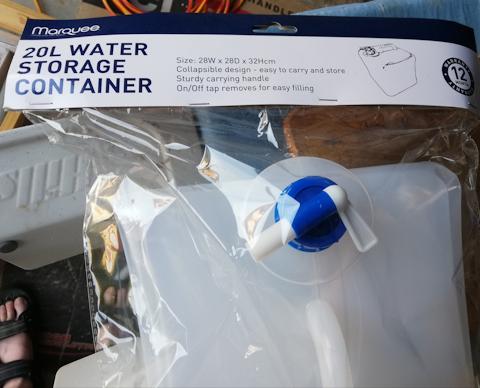
I notice that BCF have an identical-looking one for AU$19.99
Anyway, they have dinky little taps, that I realised could be used on
the distiller. Due to probably lack of UV resistance, would have to
shade them. Here is the tap disassembled:
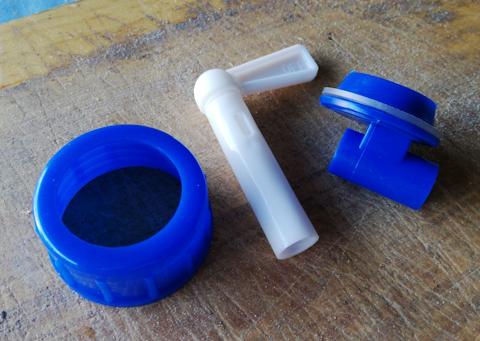
I want two of these taps, to go at diagonal opposite sides of the
basin. Yes, a tap on the inlet side also, which will serve to stop hot
air escaping. The tap on the inlet side will face up, and I plan to use a
funnel to put in precise amounts of water.
I purchased Holman 13mm end caps, from the trickle pipe fittings
section in Bunnings, and cut the end off, which gives a convenient flat
surface. Then used glue to stick it on:
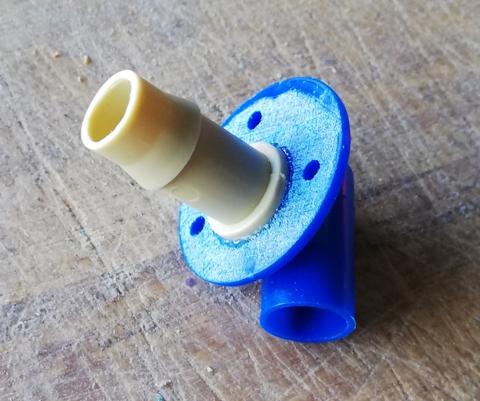
...a hole will be drilled in the wood frame, through which the 13mm
barbed-joiner will be inserted, and the holes are for screwing the tap
to the frame. Very simple, and extreme light weight.
I have mentioned the glue before. It is Selleys All Plastic Fix, which will glue any plastic:
https://www.bunnings.com.au/selleys-3ml-all-plastic-fix-primer-and-adhesive_p1230083
Changing the subject, back onto the wood frame. As I have hardly any
wood working tools, only a table and a few hand tools, I have had a
problem with holding corners in place when I screw them together --
there is the risk of slight movement. This time, I am attempting to hold
the corners in place with a bit of silicone in each corner:
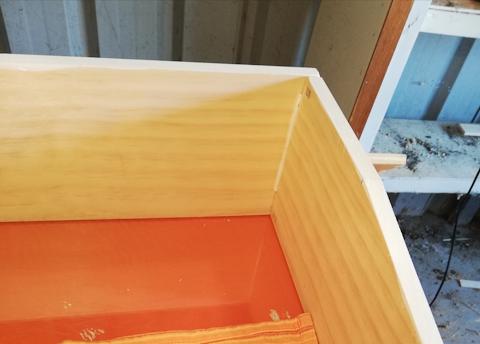
...in this photo, the frame is resting upside down on the glass.
Hopefully, once the silicone has set, I should be able to drill and
screw without movement.
EXTRA NOTES:
A couple of extra points related to this post.
Firstly, the 140x12mm pine. Bunnings only
stocks it in 2400mm and 1200mm lengths. Unfortunately, for my 672x572mm
glass, the total length of timber required is a bit over 2.4 metres. If
someone was to copy this design, slightly narrower glass, to reduce the
total wood length under 2400mm would make the wood purchase more economical.
Secondly, I am aware that the plastic used for
those taps is probably the cheapest type, with very low temperature
limit. PVC, without any additives, will soften above 60 degrees C. There
is one YouTube video, where the chap used PVC pipe for the water runoff
inside the basin still, and it sagged.
In my case, the taps will be outside the still,
and in the shade. The water pipe to the taps will be designed in such a
manner that the hot water or air does not directly reach the taps. Will
discuss this some more when construction gets to that phase.
Tags: nomad
More planning basin type prototype 2
I posted recently about basin-type prototype #1. There is a link
to testing it here, and notes about white colour for side walls in
proposed prototype #2:
https://bkhome.org/news/201911/white-walls-inside-basin-type-solar-still.html
I have got to the point of starting construction of prototype #2. In
planning, I found this document to be extremely useful:
https://www.appropedia.org/Original:Understanding_Solar_Stills
I posted recently about the Rainmaker 550 basin-type, which claims
60% efficiency. This is the absolute efficiency, of how much of the
sun's energy is actually converted to produce the distilled water (this is
different from some earlier % figures that I posted, that were relative
to the F-Cubed panel).
However, the above link states that the best that can be achieved with a simple basin-type is 43%. Hmmm.
For comparison, the F-Cubed company claim 55% efficiency for their Carocell 1000 (the one that I own).
EDIT 2019-11-24:
The C1000 model is 1x1 metres, but F-Cubed also sell C2000 and C3000, that are the same width, just longer. This gives a longer path for the rotating air, and they claim the bigger ones are more efficient, claimed 65%, with "peak efficiency" up to 80% (whatever that means).
Given how much simpler the basin-type is to build and use, this is now my focus for future prototypes. So what if it is less efficient? -- just build it a bit bigger.
Today I had a chat on the phone with Jim, a retired gentleman who also lives in Perth, and also has an ongoing interest in solar water stills. Many years ago, he built a simple basin type made with stainless steel, and a hinged glass lid for easy access to clean the inside.
Jim is interested in the F-Cubed design, but is put off by all the exotic materials in it, plastic everywhere. After chatting with me, he is also thinking of making his next build a basin type, or some enhanced variant.
As I have mentioned a few times, I want to be able to slide the still vertically into the back of my car, or future car. The basin type has considerable depth, and that is going to take up a lot of space if the still is to be packed in the car along with a lot of camping gear.
Hence, I am going for a very low angle, 10 degrees from horizontal. The appropedia.org link above, explains that sunlight gets reflected off the panel as it moves away from perpendicular to the glass. This is a good page that shows the angle of the sun in Perth, Western Australia:
http://www.see.murdoch.edu.au/resources/info/Tech/house/index.html
...what it says is that if 90 degrees is straight up, the sun will be 81 degrees at midday in mid-summer, and will be 34 degrees from horizontal at midday in mid-winter.
This is telling me that my 10 degree panel should be OK in summer, but will be at best 56 degrees off of perpendicular to the glass in mid-winter -- which is not good.
What I am proposing is a hinged reflective panel, that will be raised in winter. This is hinged along the top side of the panel, and even in summer should provide some efficiency improvement. It will also provide protection to the glass when the panel is transported.
OK, starting the build. I bought 140x12mm dressed pine from Bunnings. This is very thin, but one of the goals of this prototype is to make the weight as low as possible. I am re-using a piece of glass that was used in the sloping-type prototype #2, 672x572mm, 4mm thick. A sketch of the wood pieces:

For an angle of 10 degrees, the back side of the panel should be
162mm, but I have used 140mm wide pine. Hence the 124mm indent that you
see in the above sketch.
The two triangles that I have cut off the side pieces, could be used to make the back 162mm, if I wish.
The plan is for 30mm thick insulation in the base of the basin, and I
am investigating using a spray can of expanding foam. But that is a
story for the future...
Tags: nomad
White walls inside basin type solar still
The first prototype solar water still, simple basin type, was tested recently:
https://bkhome.org/news/201911/first-test-basin-type-proto-1.html
And the inside was coated with black silicone (except for some grey
patching, and the photo below also shows some reflected clouds):
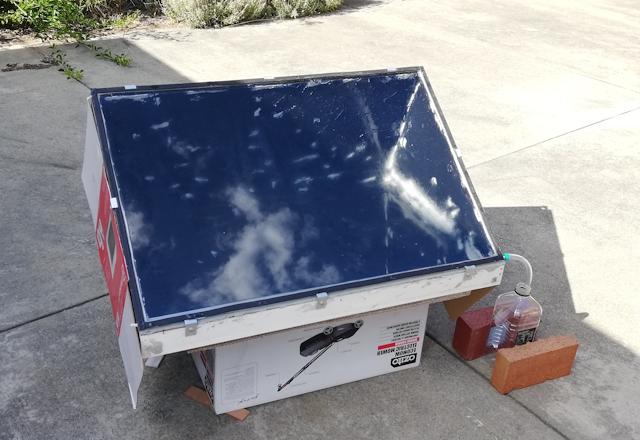
What has nagged at me though, is why are the side walls coated black?
Because that is the way it is done in all the designs that I have seen
so far!
This morning, I typed some appropriate keywords into Google search
engine, to see if there are any arguments for a different colour, such
as white, or even a reflective surface. Got hits!
OK, it seems that the rationale for painting the side walls black is to prevent condensation on the walls.
However, that also means the walls will absorb heat, and will need to
be extremely well insulated. In my prototype, they are not.
I found a couple of research papers, where the authors painted the sides white, down to the water level:
https://www.sciencedirect.com/science/article/pii/S2213020916300453
...the second author is claiming an efficiency improvement of 6.8% when the side walls are coated white.
There are a lot of variables in this analysis, but I reckon that I will go for white walls in prototype #2.
Tags: nomad
Silicone sealants for potable water
I have posted before about silicone sealants that are suitable for use in construction of the solar water distiller.
I have previously used Selleys 401, translucent, purchased from Bunnings, AU$19.63 for a 310g tube:
https://www.bunnings.com.au/selleys-310g-401-rtv-engineering-grade-silicone_p1231042
...rather expensive.
Besides, I am now wanting black sealant, and Bunnings only sell the
Selleys 401 in translucent. Also, I am now favouring neutral-cure for
applications other than glass.
I recently discovered Bostik Industrial Grade silicone, at the Total
Tools website, for AU$6.95 per tube -- except that no stores anywhere in
Australia actually stock it, and it is a "special order" with high
postal charge. Anyway, here is the manufacturer's specs page:
https://www.bostik.com/australia/Bostik-Products/Boskit-Industrial-Grade-Silicone
...Bostik is an international company, and in many places, such as
the USA, you could probably pick it up from your local hardware store.
The Fuller company, also international, do a "plumbers silicone", rated for potable water use, but not available in black.
About a week ago, I discovered Silastic 732, acetic-cure, available
in black and white, and stocked at Autobarn, a car parts and accessories
chain store in Australia. This is also rated for use in potable water.
Price is AU$18.99 per tube:
https://www.autobarn.com.au/silastic-732-black-cartridge-310g
...I bought two tubes.
There was something nagging at my memory though, another brand,
locally available. Yes, found it: Prosil 10, neutral-cure, available in
various colours including black. And cheap, AU$8.95:
https://www.indrub.com.au/prosil-10-100-neutral-silicone-300g-cartridge.html
![]()
Here is the manufacturer's page:
https://silicone.com.au/product/prosil-10/
Tags: nomad
First coating silicone on aluminium mesh
I posted recently about the idea of using an inner liner for the
basin-type solar still, constructed with aluminium insect-screen mesh
and coated with silicone sealant:
https://bkhome.org/news/201911/planning-simple-basin-still-prototype-2.html
The mesh is not raw aluminium, it has some kind of dark coating, I
presume that is an anodized surface. Don't know anything about the
properties of that surface, but the silicone seems to stick to it OK.
Now for the next step, to coat a large piece of mesh. The intention
is that this will be inserted inside the distiller frame, and will
completely isolate the frame from moisture. There will also be some
insulation injected between the inner liner and the frame. Still
planning on using pine for the frame.
Want one large coated surface, which will be folded afterward, so a
minimum of cutting -- basically, the only cuts will be for inlet and
outlet holes, and to trim the edges where the liner is sandwiched under
the glass -- anyway, those details will be clarified as the project
progresses.
Here is a photo of the mesh stretched out on a table:
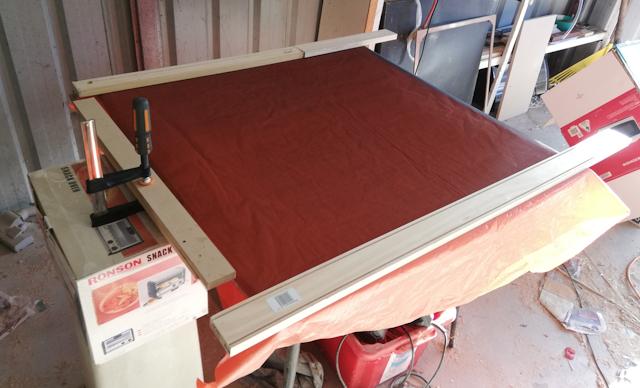
...the g-clamp has two purposes, to prevent the mesh from folding up
when I lift it off the table, and to hang it up on a hook. The other end
has a length of small-section wood attached with wire.
Underneath the mesh is plastic sheet. That plastic just arrived in my
backyard one day, a year or so ago. Thought it might be useful, so put
it in the garage -- so, finally it has a use!
Wanted an area about 950x750mm. Used cheap Parfix
kitchen-and-bathroom acetic-cure silicone sealant from Bunnings -- this
has anti-mold additive, which I don't want, but it shouldn't matter in
the final product, as it will be coated inside with black Silastic 732
sealant.
The end result was hung up:

...the white spots and streaks are holes. I have learned from
experience not to try and patch the holes. Instead, let it set and
tomorrow will give a second coat. Note, that large white area at the
bottom is direct sunlight. One more detail: I wiped the plastic with a
cloth, to remove silicone bumps, as the plastic will be used again
tomorrow.
Tags: nomad
Planning simple basin still prototype 2
I posted a test of the simple basin prototype #1 yesterday:
https://bkhome.org/news/201911/first-test-basin-type-proto-1.html
The result was promising, so decided to go ahead and design prototype
#2. A major requirement is that it be as flat as possible, so as to
take up little space when slid into the back of a hatchback car or 4wd
vehicle. In fact, that was one of the main reasons, that and promised
improved efficiency, that I went for the tilted wicking-cloth type of
still. However, I have now learnt that the glass can be very close to
the water, water depth can be mere millimetres, and the glass angle can
be as little a 5 degrees, maybe even lower.
It may be possible to design the still to be only about 100mm (4
inches) thick at the widest end, which would be great. However, might
not quite get that thin. This reference recommends a minimum glass angle
of 10 degrees (scroll to page 445):
https://books.google.com.au/books?id=H8aJC5BWCSEC&pg=PA445#v=onepage&q&f=false
...it is unclear whether that 10 degrees figure is for plastic panes.
Water droplets stick to glass better, and perhaps it would still work
for angles less than 10 degrees.
The above reference also recommends water depth of 20-30mm and side and bottom insulation thickness of 20-30mm.
In all of my reading, I keep coming back to silicone as the superior
product. Inert, extreme resistance to corrosion and UV light, and
retaining its flexibility for 10-20 years.
Rather than build the still out of wood, as I have done so far, I am
thinking of using aluminium insect screen mesh, coated with silicone
sealant. This would give me a flat surface that I can bend into shape,
to form the basin and support for the glass. There could be an outer
frame, into which insulation is poured -- maybe polyurethane expanded
foam -- or even silicone mixed with foam bubbles.
Thinking along these lines, I have started testing coating of insect
screen mesh. I bought a roll of aluminium mesh, 1220x2050mm, AU$23:
https://www.bunnings.com.au/cyclone-1220mm-x-2-05m-aluminium-insect-screen_p4110400
Also some cheap Parfix brand acetic-cure white silicone sealant, AU$6.68:
https://www.bunnings.com.au/parfix-300g-white-bathroom-and-kitchen-silicone_p1232690
I have a plastic spreader, that was used for the early wicking-cloth type prototypes:
https://www.bunnings.com.au/uni-pro-wallpaper-smoother-and-straight-edge_p1661659

I tested spreading on a mesh offcut, with newspaper backing, plastic backing, and hanging vertically in the air:
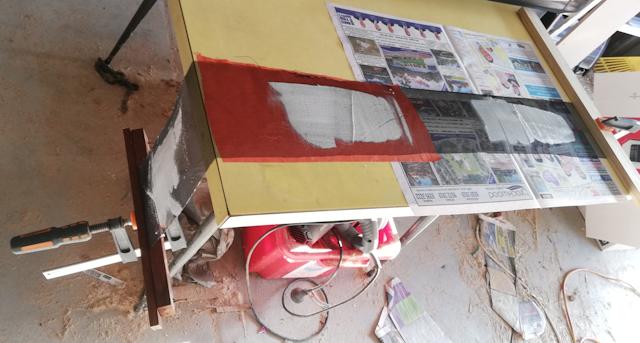
I then pulled the backings off and hung it up to set.
From this initial test, it looks like two or three coats will be
required. For the final construction, I will probably do two coats of
cheap white silicone, then one coat of black Silastic 732
silicone. In earlier experiments I found that silicone-on-silicone
adheres extremely well, so there will be no adverse issues with doing
multiple coats.
Tags: nomad
First test basin type proto 1
Yesterday I posted some design notes, and construction details of
a first prototype of a simple basin-type solar water distiller, using
parts found in my garage:
https://bkhome.org/news/201911/simple-basin-solar-distiller-design-notes.html
After knocking it up, further reading revealed some design
shortcomings. However, this first prototype will probably be useful for
"ball park" measurements, to see if this type has potential. As already
stated, I was very surprised at the claimed output of the Rainmaker 550,
and if I can also achieve this level of efficiency, then this simple
design looks like the best way for me to go.
Here in Perth, Western Australia, we are having our first summer
heatwave. Prediction today was 40 degC (104 Fahrenheit), superb day for
testing!
I set it up early in the morning. The previous evening, I had stuck
some cardboard on the sides, a rather feeble attempt to improve the
insulation, don't know if it will make much difference. Here it is,
photo taken at 8.20am, the sun has just hit the top corner:

...I only put in 3 litres of water, as efficiency is said to be
improved with less water depth. Glass is 600x900, as is outside
dimensions of the base, so water depth is only a few millimetres.
Oriented the panel for peak output at about 11am, and waited for the
sun to march across the panel. About 9.00am had sun on all of the panel,
and a tiny bit of distilled water appeared, so started measuring from
9.00am.
9.00am. Some gusty wind. Sunny sky with some fluffy clouds.
10.30am. Sun: 870 W/m2, ambient: 31 degC, temperature about
3/4 up the panel, IR sensor about 2 inches away from glass: 53 degC, 1/4
up: 52 degC, back side of distiller, about 2 inches away: 39 degC
12.00 noon. Only very slight breeze. Fluffy clouds mostly gone. Sun: 890 W/m2, ambient: 34 degC, 3/4: 64 degC, 1/4: 63 degC, back: 45 degC
1.30pm. Sun: 960 W/m2, ambient: 38 degC, 3/4: 64.7 degC, 1/4: 64 degC, back: 48 degC
3.15pm. Stop.
Collected distilled water: 1.525 litres
Collection duration was 6 hours and 15 minutes, so collected 244
millilitres/hour. Collection area is 0.568x0.868 metres2 which is 0.493
m2.
Now for the exciting part, to compare with the F-Cubed panel.
Different weather conditions of course, so this comparison is a very
rough guide only. Refer to prototype #4 results:
https://bkhome.org/news/201911/solar-distiller-prototype-4-first-test.html
Quoting, result for prototype #4:
the collection: 1.1 litres, in 7 hours. That is 157 millilitres/hour. The cloth has a surface area of 0.3327 m2, so to compare efficiency with the F-Cubed panel which is 1 m2, need to scale up: 157*(1/0.3327) which is 471.9 ml/hr. The F-Cubed panel gave 563.6 ml/hr, so the test has a comparable efficiency of 83.7%.
Today's test (simple basin type, prototype 1) also needs scaling: 244*(1/0.493) which is 495 ml/hr. Efficiency relative to the F-Cubed panel is 87.8%
Wow! And that's with a design that probably has room for improvement.
I must re-state that these comparison percentages may be way off. The F-Cubed was tested mid-winter, full sun but much lower ambient temperature. I really do need to set up my panels alongside each other for a proper comparison test.
The most obvious improvement that can be done, as seen from today's
test, is to improve thermal insulation on sides and bottom. At 1.30pm,
the back side of the panel measured 48 degC, 10 degC above ambient.
Another area of improvement will be to decrease glass angle, and
bring glass very close to the water surface. There is however, a
tradeoff, as if sun angle to the glass is more than about 70 degrees off
perpendicular then it just reflects off the glass. A balance needs to
be found, to suit summer and winter sun angles.
Tags: nomad
Simple basin solar distiller design notes
A few days ago, I posted about the Rainmaker 550 single-slope simple-basin type of solar water distiller:
https://bkhome.org/news/201911/rainmaker-550-solar-water-distiller.html
...for which the manufacturer claimed remarkably high distilled water
output. I want to find out for myself, so decided to build one, no, at
least two.
I re-purposed prototype #2, which was the trickle-down type, just one
sheet of glass, and the frame was MDF. The interior was coated with
silicone sealant. That was built back in June:
https://bkhome.org/news/201906/diy-solar-water-distiller.html
...took those legs off, and it then became the water basin. Cut some
more pieces of MDF, and coated the inside with black silicone sealant,
then a bit more patching with some leftover grey sealant:
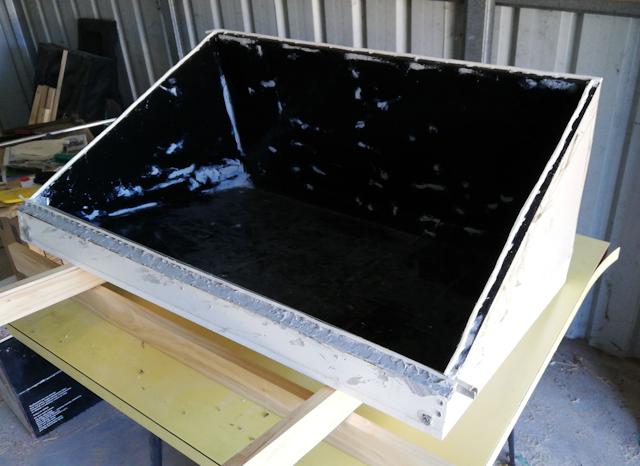
...also stuck some foam silicone strips on top, and the glass
(600x900mm) will just sit on top. Used a length of 10x10mm aluminium
channel as the distilled water runoff.
I used cheap Parfix brand black sealant, two 310 gram tubes, used it
all, hence resorted to the grey sealant for final patching.
For the record, black silicone sealant rated as "food grade" and
"potable water" safe, is Silastic 732, available at a very reasonable
price from Autobarn (Australia), AU$18.99:
https://www.autobarn.com.au/silastic-732-black-cartridge-310g
The build so far is good enough for basic ball-park testing I
suppose, however, there are two things "wrong" with this design -- let's
call it prototype #1 of the simple-basin design.
Firstly, there is going to be too much heat loss. This design needs
insulation, and I might just stick cardboard onto the sides and bottom
of the MDF.
Secondly, the glass angle is 35 degrees, however, after some more
reading, I found a recommendation that the optimum angle is 15 degrees.
This information comes from here:
https://www.appropedia.org/Improving_Basin_Solar_Stills
...which has a link to this PDF which is where the 15 degrees figure came from:
https://www.ircwash.org/resources/solar-powered-desalination-case-study-botswana
Another recommendation is that the water depth in the basin be kept low, like about 10mm. Can do.
I could cut a slice out of it to lower the angle, but might just leave it as-is, the after some testing, move onto prototype-2.
For basin-prototype-2, might investigate a better insulating
material. I am thinking of black corflute, such as Tunnelcore, from
Bunnings:
...corflute is made with polypropylene, and Tunnelcore has UV
resistance. Polypropylene is one of those slippery kind of plastics that
is very difficult to glue. I am planning to experiment with
heat-gluing.
Tags: nomad
